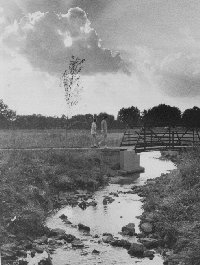In some respects, the challenges of MSD’s second half-century may seem more formidable than the challenges of the first.
In 1946, the tasks were large but relatively simple: take over and maintain the city’s aging sewer system, expand sewer service to city residents who didn’t have it, plan to expand service to the suburbs, build the community’s first sewage treatment plant — and find the money to finance it all.
By 1997, MSD had surpassed most of these original goals. Sewer service had been extended far beyond the area imagined in 1946, and was continuing to expand. MSD was operating a series of treatment plants of various sizes, all of them removing much more waste than was thought possible in 1946. And financing, after decades of struggle, seemed relatively stable and assured.
But the demands of the late 1990s are also much greater than anyone imagined in 1946. Most people now want our streams to be as free as possible from mankind’s contamination, and most want an end to the local flooding caused by generations of unwise development. Achieving these goals poses enormous scientific and engineering challenges.
Reducing stream pollution is the goal of several major programs, all expensive. Eliminating the community’s combined sewer and sanitary sewer overflows is expected to take two to three decades, and account for 30 percent of MSD’s capital program. Eliminating pollution from stormwater runoff may be even more difficult. And new sewers must be a part of all new development if the streams are to be protected.
Public concern over drainage is expected to bring stricter controls over development. Controlling future development will be difficult enough; correcting the mistakes of the past — especially where homes and businesses were built on former marshlands and in flood plains — could be enormously expensive. One of the measures being considered is to require new development to help alleviate old drainage problems.
"There’s so much work for us out there, that it’ll never be done," said Sandra J. Metts after retiring as MSD’s board chairperson in mid-1997. "There isn’t enough money to do it all."
Reba M. Doutrick, who succeeded Metts as chairperson, listed one of the major tasks as determining MSD’s eventual geographic scope.
"We’re called ‘metropolitan’," she said. "How much of the metropolitan area shall we serve? Will we eventually become a regional agency? Adjoining counties’ water and pollution comes our way; it makes sense to clean it up before it gets here."
Gordon R. Garner, MSD’s executive director, agreed that the challenges are great — but said new approaches will help MSD and the community to deal with them.
Two major initiatives illustrate these new approaches: watershed management, and the Greenways Program.
Watershed management, initiated in 1997, groups all of MSD’s activities in the watershed of a stream into one integrated program. Treatment plants, sewers, overflows, pollution from septic tank seepage and washed from the land by rain, stormwater drainage, and flood control measures are all coordinated, with one goal in mind: to reduce the pollution in the watershed’s streams as much as possible.
The Greenways Program, initiated by MSD with the help of other government agencies and environmental groups in the early 1990s, aims to establish natural corridors along the community’s streams and return the streams themselves to a more natural state.

MSD Photo by Martin E. Biemer
"If I had to predict one element of our programs that will have the most profound impact on our community over the next 50 years, it is our Greenways/stream preservation program," Garner said.
"From the time of settlement, the standard approach — even in our parks — was to ‘channelize’ the stream (to help water flow faster). Starting now, we have different standards.
"Streams must be preserved and adjacent greenways will be encouraged and required. New areas will be greener, with a balance between the natural environment and new development. In older areas, we will have opportunities with our flood control projects to restore streams and provide greenways in areas that lack them.
"Greenways will line our local streams, and the Ohio River Trail greenway will run from one end of the county to the other. Our whole community will reorient to our river and streams. Our waterways will be valued, and water quality will be much better than it is today."
MSD History - Return to the beginning


